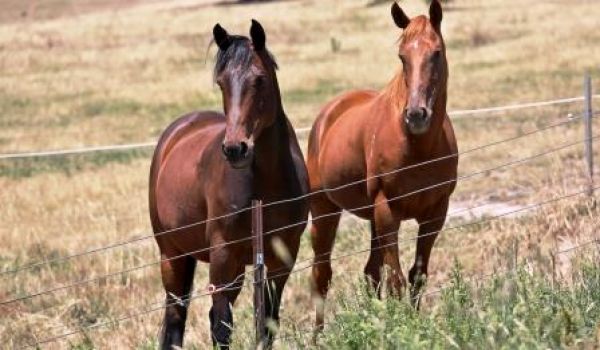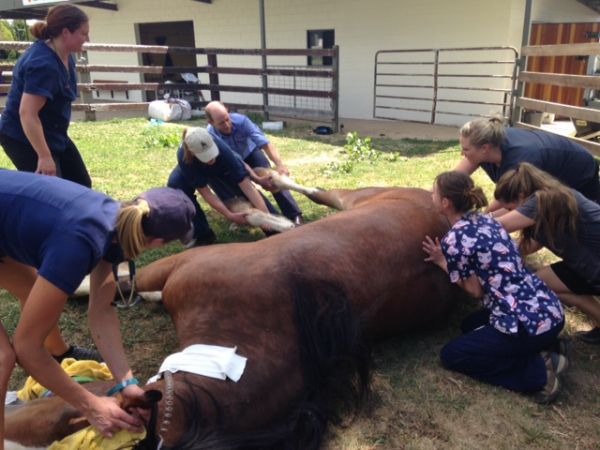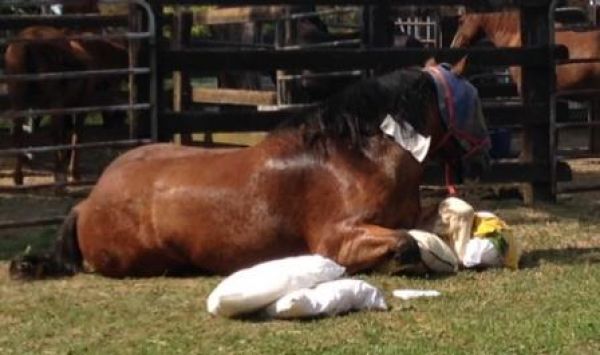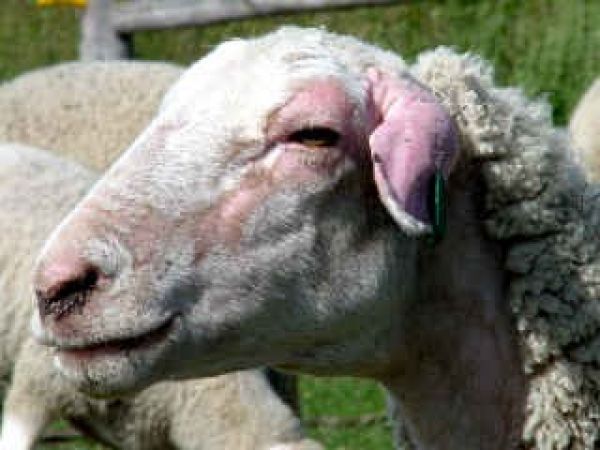 |
|

|
 |
 |
January Large Animal News |
January 2016 |
 |
|
 |
We love working together....
Veterinary and support staff at OVH are proud to be part of an effective integrated team who work together to achieve successful outcomes for our patients.
Everyone plays an integral part in patient care - from the reception team member who you may first speak to, to our experienced vets who assess and diagnose ailments and provide essential emergency care for injured patients through to the busy treatment area where patients are nursed, undergo medical procedures and surgeries and are tended to with great care by our nurses.
This team effort was very much in evidence with a recent patient Hercule.
Hercule, a 6 year old Clydesdale, unfortunately presented with a skin cancer lesion on his right eye - effective treatment involved removal of the eye. Dr Kate Burnheim, Hercules's treating vet, performed the successful surgery with a very effective team behind her - not only with management of his anaesthetic but also in being able to move him while anaethetised. Hercules was no small horse weighing in excess of 800kg! We managed to snap a picture to show how many hands were required on the day and also of a resting Hercules post surgery...he is now home and managing very well with his one healthy eye.
Just one of the interesting days at Orange Vet Hospital.
|
 |
 Hercule being moved while under anaesthesia - Together Everyone Achieves More.

|
 |
 |
|
|
|
 |
 |
01 Spotlight on Photosensitisation |
 |
 |
 Photo courtesy http://www.pipevet.com/content/Photosensitization.asp
|
|
 |
What is photosensitization?
Vet Genevieve Payne together with final year vet student Sophie Woodhouse, currently working with us, explain the disease process and how it affects our livestock.
Photosensitisation is an inflammatory skin condition affecting livestock, particularly cattle and sheep. It occurs as a result of an abnormal reaction of the skin to bright sunlight, usually following the ingestion of toxic plant species such as St John’s Wort, Buckwheat and Hairy Panic amongst others.
When exposed to bright sunlight, unprotected or unpigmented skin around the ears, eyelids, nose and lips becomes reddened and swollen. This causes the ears to droop, eyelids to close, with difficulty breathing and eating if the nostrils or lips are affected. Animals appear restless and may be seen rubbing against fixed objects, seeking shade or shaking their heads. In severe cases, the skin may slough off, and death may result.
Outbreaks occur most often in spring and summer with access to lush, green pasture. A diagnosis is made based on clinical signs and access to toxic pasture.
Whilst the prognosis is poor for extremely affected livestock, early recognition and treatment will minimise losses. Treatment and prevention is aimed at removing access to toxic plant species and protecting the stock from sunlight, providing adequate water and grazing on cereal hay with minimal green colour. For valuable or severely affected stock, veterinary advice should be sought.
For more information, visit our website http://orangevet.com.au/livestock-articles/
|
 |
 |
|
 |
 |
02 Does your horse have ringworm? |
 |
 |
|
 |
Ringworm is a common fungal disease of horses affecting the skin, commonly of the head and neck. It is highly contagious between horses, and can occasionally infect humans. The disease is spread by direct contact, or horses sharing grooming equipment or rugs. Young horses and those with weakened immune systems are more commonly infected than older horses. After infection has resolved an immunity to the disease develops which can last years.
Diagnosis: Ringworm is suspected based on the appearance of small, often circular areas of hair loss. It can be confirmed by finding fungal organisms under the microscope after taking a skin scraping, or by laboratory culture.
Treatment: Management of ringworm involves medicated anti-fungal shampoos, and systemic treatments are available for severe infection. Although ringworm will often resolve without treatment in 2-3 months the skin lesions become quite uncomfortable, and infected horses can spread the disease to healthy horses therefore treatment is usually recommended.
Prevention - once again better than a cure! By adhering to usual quarantine protocols such as isolating new horses for 2-3 weeks and practicing good hygiene between horses you can help prevent the spread of ringworm on your farm. Infected horses should be kept isolated, handled using gloves, and equipment should be washed after use.
Ringworm can often be mistaken for rainscald and other skin conditions which are managed differently. Our trained veterinarians are best qualified to advise on the diagnosis, treatment and prevention of ringworm in your horses.
|
 |
 |
|
 |
 |
03 A little something about sperm |
 |
 |
|
 |
Did you know that the morphology (anatomy) of sperm has been shown to be one of the most important indicators of fertility in bulls? This makes it a very useful selection tool for improving herd fertility.
What is sperm morphology?
Sperm morphology refers to the shape, size and structure of the sperm. During a BULLCHECK™ the vet assesses sperm quantities and its ability to move forward and reach the egg (motility). A sample of semen is then preserved and assessed by a ‘semen morphologist’ who counts 100 sperm and classes them as normal or abnormal.
Why is sperm morphology important?
Morphology results can predict the sperm’s ability to get a calf from the egg and, importantly, can pick up defects that may cause an egg to be fertilised but then fail to result in an ongoing pregnancy.
Morphology assessments are important because sperm morphology:
- Has been demonstrated to be heritable
- Is relatively repeatable (doesn’t change much from year to year)
- Can be used to predict the number of calves the bull can produce
- Can predict the fertility of his male and female offspring
- Influences the age a heifer goes through puberty and her time between calving and resumption of cyclicity
Selection of bulls with high normal sperm morphology counts results in:
- Increased calving rates
- Tighter calving periods
- Reduced empty cows
- Increased weaning weights
- Faster rates of genetic gain
How can producers benefit? Only purchase bulls that have passed a morphology test. Ask to see the actual morphology test result and select bulls with the higher percentage normal. Bulls which fail morphology testing will cost you money (even if you don’t pay for them).
How can bull sellers benefit? Breeders selling morphology tested bulls should be proud of their high standards which will be reflected in the long term quality of their product and their reputation.
|
 |
 |
|
 |
 |
04 Summer rain and the barber's pole |
 |
 |
|
 |
With pockets of summer rainfall coming across the eastern states of Australia, it is very important to be on the lookout for the barber’s pole worm in sheep. This worm generally loves the high summer rainfall regions of QLD and Northern NSW, however it is found in all states especially after a period of summer rain.
Barber’s pole worm is not only production limiting, but in severe infestations will cause death, anaemia, lethargy and collapse. Bottle jaw is another classic sign of the worm. All classes of stock are susceptible, but as with all parasites, the youngest and the oldest stock are particularly vulnerable.
Most sheep farmers will have already done the first summer drench as the season dried out through November and December (and possibly earlier this year). Lambs should have all been drenched at weaning, which will likely have coincided with the first summer drench.
After the first summer drench, it is important to be monitoring the worm burden among your flock. WormTests should be conducted at 4-6 weekly intervals after the first summer drench. If you have had significant summer rain, be on the cautious side and even reduce the interval to 3 weeks. This may lead to a second summer drench come late January or February.
Using combination drenches will be the most effective, and if you are unsure what is working on your farm, DrenchTests are important.
Remember, all new stock coming on farm require a quarantine drench to prevent you bringing resistant worms onto your farm.
The best source of information on all things sheep and drench related is found at Wormboss
|
 |
 |
|
 |
 |
05 What you need to know about milk & blood pregnancy testing |
 |
 |
|
 |
If you are considering trying out milk or blood pregnancy testing, there are a few important things you need to consider first. While these tests do have an application in certain settings, unless you fully understand the way they work, it could become a very expensive exercise for you.
How do they work?
Both the milk and blood pregnancy test detect a set of proteins which are produced by the placenta when a cow becomes pregnant. These proteins are called Pregnancy Associated Glycoproteins (PAG). The proteins are first detectable at 24 days of pregnancy, but only reach diagnostic usefulness at about 28-30 days post AI. They are still present after calving for a period of about 60 days.
How good are the tests?
At first glance, the statistics which are provided by the company to support using the milk pregnancy test sound excellent, with 98% sensitivity (ability to detect a pregnant cow) and 97% specificity (ability to detect an empty cow). About 4% of cows are called as rechecks. But what does that mean in a real life scenario?
Take a 200 cow herd where around 60% of cows are in calf (e.g. a normal first round pregnancy test in a seasonal herd). The test will come up with 6 incorrect results when compared with ultrasound.
- Out of the 120 pregnant cows, the test will call 1 empty.
- Out of the 80 empty cows, the test will call 5 pregnant.
Would you accept 6 errors out of 200 cow herd or 18 errors in a 600 cow herd from your vet?
What are the other limitations of the test?
- Can’t be used for ageing
- The cost of the test is between $4 to $6, plus the cost of herd testing
- Results take 2-3 days
- Errors can occur with sample handling (errors are common during herd testing)
- Can’t detect other problems such as damage to the uterus, cysts, foetal mummies or pyometras (pus in the uterus)
This information was written and republished with the permission of Dr. Matthew Izzo and Dr. Jon Kelly
|
 |
 |
|
 |
 |
06 PREgCHECK™ VS milk & blood pregnancy testing |
 |
 |
|
 |
We have been asked whether milk and blood pregnancy testing is effective for early pregnancy diagnosis and re-synchrony. The test performs slightly differently depending on the stage of pregnancy. The highest percentage of errors occur when the test is used for early pregnancy diagnosis.
When used between 5 and 8 weeks of pregnancy, the test will call a higher percentage of empty cows pregnant than at other stages of pregnancy (8 incorrect calls out of 100 empty cows). This occurs when the foetus has died but the test is still able to detect the hormone from the placenta – in most dairy herds early foetal loss is relatively common, especially in high-producing animals.
What are the scenarios where the test could be used?
- Where there are no facilities to safely perform pregnancy diagnosis
- Where a skilled veterinarian is not available
What is your best option?
The above statistics are a comparison to the gold standard of pregnancy diagnosis, rectal palpation or ultrasonography, which achieves over 99% accuracy. While the accuracy and precision of pregnancy testing with these methods depends on the experience of the person performing the test, there is a quality assurance scheme that the Australian Cattle Veterinarians have established. This scheme is known as PREgCHECK™ (Professional Reproductive Examination). To become PREgCHECK™ accredited, vets must:
- Pregnancy test 2000 cows before attempting the examination
- Examine 100 cows of mixed pregnancy status during the exam, and
- Not misdiagnose one pregnant cow as empty or vice versa
- Not have variation of more than 2 weeks for pregnancies up to 4 months and of more than 1 month in pregnancies over 4 months
Inaccuracy costs a lot of money. As vets we know and understand the value of accurate pregnancy diagnosis, and work to ensure you get the maximum return on your investment in our service.
|
 |
 |
|
 |
 |
07 The importance of equine dental health |
 |
 |
|
 |
All horses and ponies require dental attention at different stages in their life. Young horses, like kids, gradually lose their baby (deciduous) teeth as their adult teeth grow through. Retained deciduous teeth, called caps, can trap food in the mouth causing painful gum disease and can lead to infections. The first pre-molars, called wolf teeth, can fracture under pressure from the bit if left in place, and we often remove them during a horse’s first dental procedure using sedation, pain relief and local anaesthetic.
Even just normal chewing can cause sharp points to develop on the cheek teeth, which can damage the gums and tongue, causing painful ulcers. Damaged areas of gums surrounding teeth can develop infection, which can even spread to the root of the tooth, causing extremely painful tooth root abscesses.
A horse or pony with poor dental health can lose weight and resent the bit during riding. Poor dental health may also lead to an increased risk of colic caused by poorly chewed food blocking the digestive tract.
Signs of dental disease to be aware of in your horse include:
- dropping feed
- weight loss
- foul breath
- swelling of the face or lower jaw.
Veterinarians are best able to perform a detailed dental examination and treatment safely and effectively using sedation and pain relief. We can x-ray the teeth for diagnosis of more complicated dental issues.
Call us to arrange a dental checkup for your horse today.
|
 |
 |
|
|
